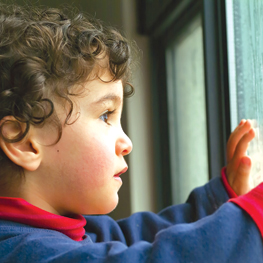
With tornado sirens howling, thunder crashing and lightening forking through dark clouds, most anyone might feel a mixture of unease and awe with nature’s dramatic display. Many families, however, would prefer to skip the show given the emotional havoc storms wreak on their kids.
DeTonya Childress says her daughter Alexia, nine, becomes frantic during severe weather. Alexia’s fear manifests as tears and quickly progresses to pleas for an immediate retreat to the basement.
“Tornadoes and thunderstorms are the worst,” says Childress.
“When Alexia was three years old, she decided to sleep in her own bed during a storm. The first crack of thunder led her back to my bedroom, crying all the way. [Now] once in my room, she begins to pray.”
If volatile weather sparks a crushing wave of panic in your child, calm storm preparation, soothing relaxation techniques and a dash of Weather 101 may help ease their fears.
Calm before the storm
Begin managing weather-related anxiety with calm, confident preparation.
“The most important thing that parents can do is prepare their children for severe weather way before it happens,” says Dr. Edward Christophersen, pediatric psychologist at Children’s Mercy Hospital.
“Parents need to be cognizant that their behavior directly influences their child’s behavior. So parents should very calmly practice their threatening weather procedures.”
Create a severe weather plan with your family. Designate a safe area in your home, preferably a basement, or a bathroom or closet in the middle of the house on the lowest level. Store a storm safety kit in your safe area that includes a battery-powered weather radio, flashlight, blankets, a pair of leather gloves and safety whistles.
With storm season imminent, take a few minutes several times a week to conduct family storm drills. Set up a small table in your basement for you and your family to engage in a familiar and relaxing activity like a board or card game. When threatening weather happens, calmly follow the plan you and your family practiced.
Relaxation techniques
Play weather sounds for your child while you’re relaxing together, playing a game, eating dinner or while your child is doing their homework. Begin with very gentle sounds like a light rain and slowly progress to more serious rain and thunderstorms.
“The rationale here is to get the child to pair or associate weather sounds with frequently occurring activities that are not anxiety-provoking,” says Christophersen.
Download free weather sounds to your laptop or smart phone. Apple’s iTunes™ offers a free application for iPhone called ‘Sleepmaker’ that Christophersen recommends.
Weather 101
Throughout the year, TV meteorologist Gary Lezak facilitates weather presentations at schools with his canine partner, Stormy the Weather Dog. It’s not unusual for Lezak to encounter children who fear thunderstorms and tornadoes. He finds that explaining the sporadic nature of tornadoes and how storms work can ease some of their worries.
Lezak teaches students to track the movement of a storm. He explains that after lightening flashes, they can count “one-one-thousand, two-one-thousand” and so on until they hear thunder.
“Every five seconds is one mile because sound travels much slower than light,” he says.|
He encourages the kids to stay inside and play the game during a thunderstorm to see if the storm is moving closer or farther away.
When to seek help
Children commonly experience specific fears or phobias, but typically phobias wane as kids grow older. If your child’s phobia lasts more than six months and impairs their ability to participate in daily activities, find an experienced anxiety disorder therapist with supervised clinical experience in treating phobias. Christophersen says a reputable therapist will likely conduct a standardized anxiety screening. Avoid therapists who want to start therapy by giving your child an IQ test.
Tips to prevent weather anxiety
During a gentle, non-electrical rain, grab an umbrella and head outside with your youngster. Discuss how the rain helps give the grass a drink.
If you have an infant, stand under your garage or porch and put their hand out into the rain to feel the rain drops.
Avoid anxiety-provoking behaviors like nervous pacing or anxious hovering around the weather radio or TV.
Seek professional help if you are unable to cope during a storm.
Freelance writer, wife and mother, Christa finds the changing seasons are as moody as a cantankerous toddler. She is the author of Confidently Connected: A Mom’s Guide to a Satisfying Social Life.
Calgary’s Child Magazine © 2024 Calgary’s Child